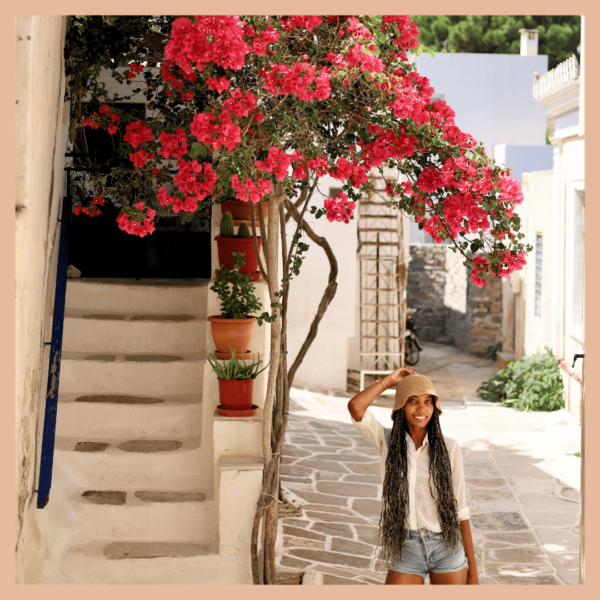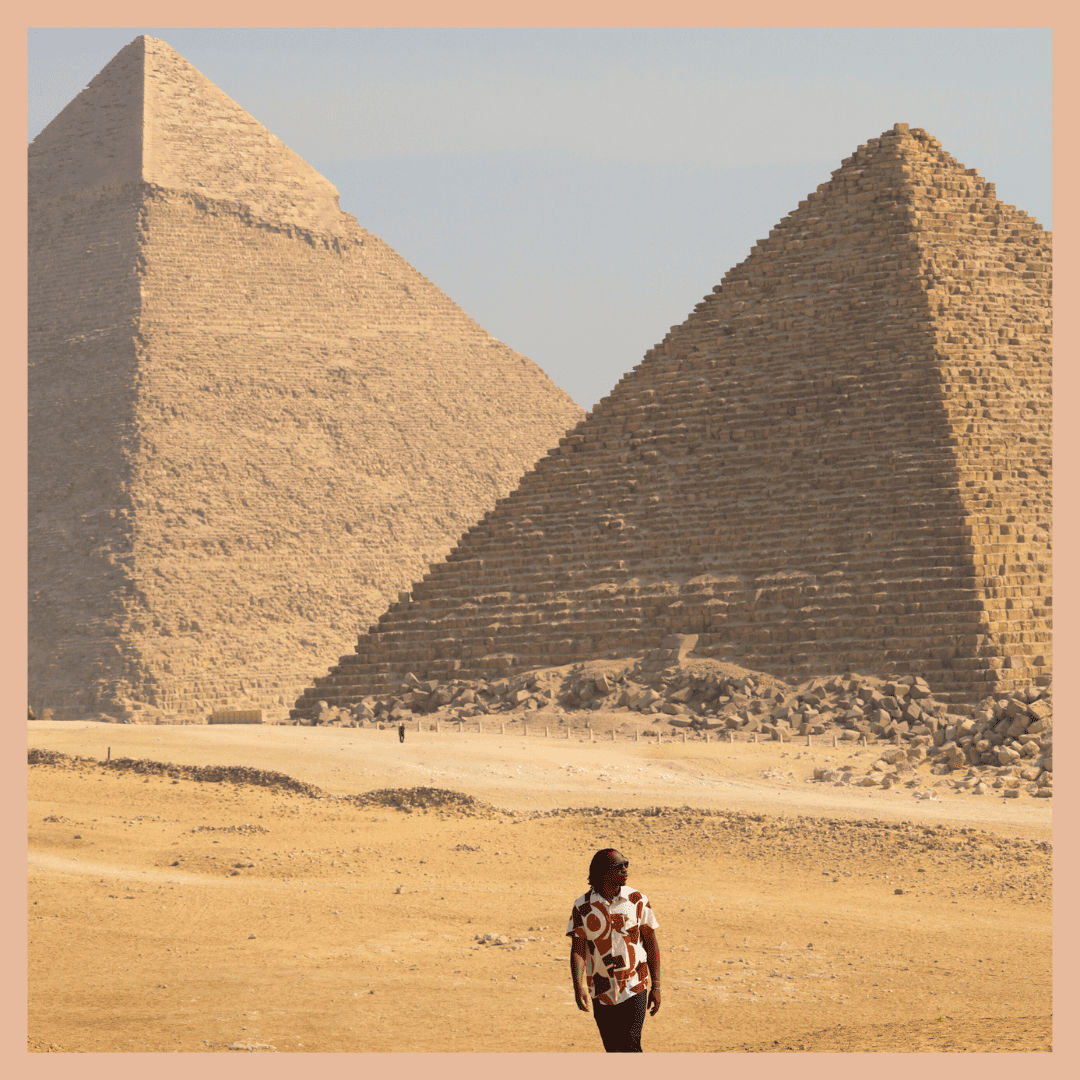
Looking for the best things to do in Cairo, Egypt? From iconic landmarks to local experiences, this guide covers what to see, how much to budget, and tips to make the most of your visit.
Disclosure: This post may contain affiliate links, which means we’ll receive a commission if you purchase through our links, at no extra cost to you. Please read full disclosure for more information.
If you’re heading to Egypt, chances are Cairo will be your first stop.
This lively city is packed with ancient wonders, busy markets, and historic mosques—making it more than just a gateway to the Pyramids of Giza.
Whether you’re here for a quick visit or using it as a base before heading to Luxor or Aswan, Cairo has plenty to offer.
After spending a week exploring Egypt, we got a real feel for what’s worth your time in and around the capital. In this guide, I’ll share:
- Entry fees and costs so you can budget accurately.
- Personal insights on what makes each spot memorable.
From must-see landmarks to local experiences you shouldn’t skip, this list will help you make the most of your time in Cairo.
Pyramids of Giza
It’s hard to imagine visiting Cairo without seeing the Pyramids of Giza.
Even if you’ve seen countless photos, nothing compares to the moment you spot them in real life.
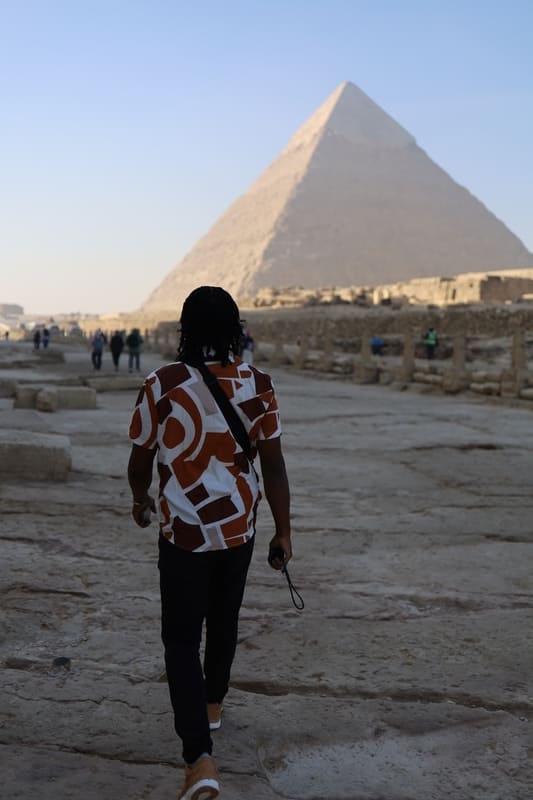
The drive over is surreal—you’ll turn a corner and suddenly see these massive, ancient structures rising from the desert, seemingly out of nowhere.
First, you’ll catch a glimpse of one, then another, and before you know it, you’re staring at thousands of years of history.
Once you get up close, it’s impossible not to wonder: How did they build this?
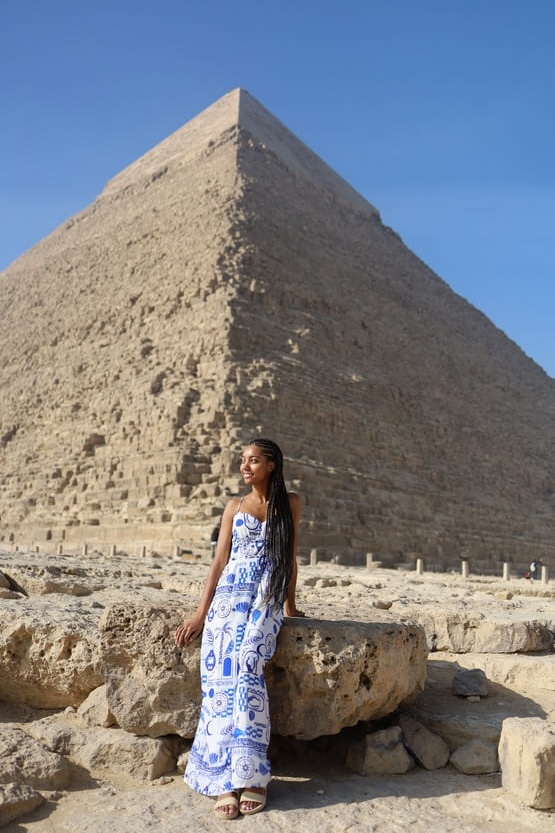
The sheer size of the individual blocks—some weighing up to 15 tons—makes you question how they were lifted and stacked with such precision.
The perfectly symmetrical design and massive scale will leave you staring in awe, trying to wrap your head around how humans pulled this off without modern machinery.
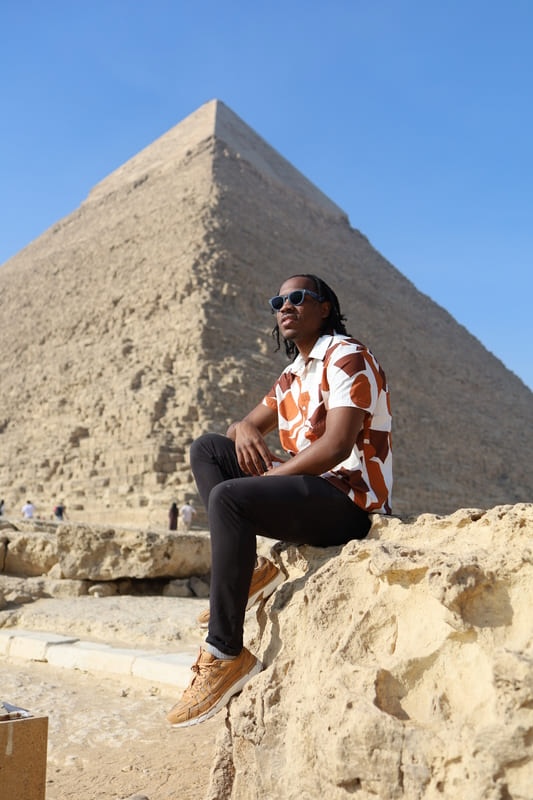
How to Get There
There are plenty of guided tours available, but the most budget-friendly option is to simply take an Uber.
- Estimated Uber cost from central Cairo: ~150–200 EGP ($3–$4 USD) one way.
- From the airport: ~350–450 EGP (~$7–$9 USD) one way.
Uber prices fluctuate, but it’s still the most affordable and convenient way to get there.
When to Visit
We visited the Pyramids twice—once early in the morning around the time they opened and again at midday.
Surprisingly, it was more crowded in the morning, with heavier traffic driving up to the entrance.
When we returned around 1 PM, there were fewer people and less congestion.
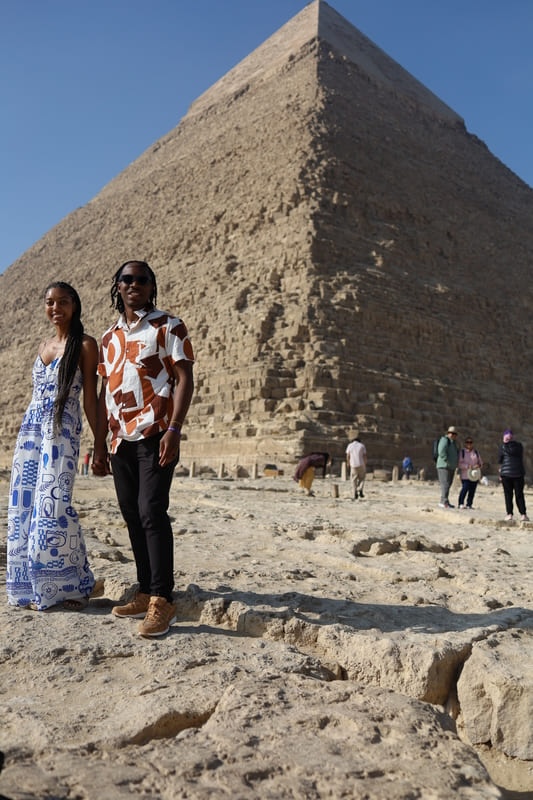
Entry and Security
When you arrive, you’ll find ticket kiosks as well as people behind booths who can assist you with purchasing if you prefer.
Entry is card-only—they do not accept cash.
- Adult ticket: 700 EGP (~$14 USD)
- Student ticket: 350 EGP (~$7 USD) – valid physical ID required
Once you have your ticket, you’ll pass through security screening. You’ll scan your ticket to enter the complex.
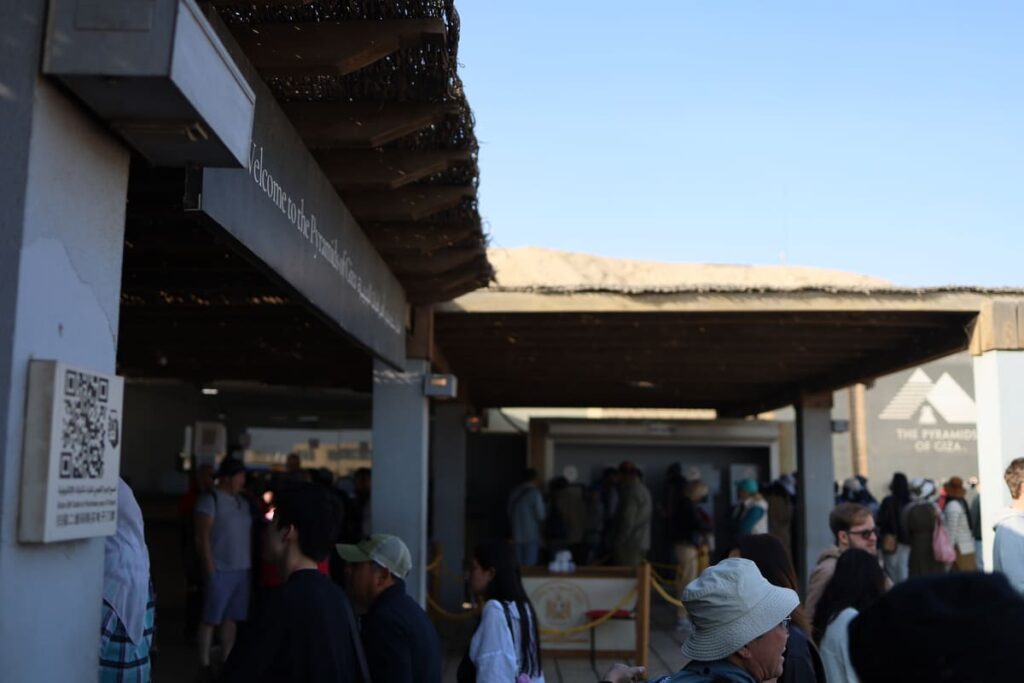
Going Inside the Pyramids
For an extra fee, you can enter the pyramids themselves, though we opted out.
From what we’ve heard, the interior experience is mostly narrow, dark corridors rather than visually striking chambers.
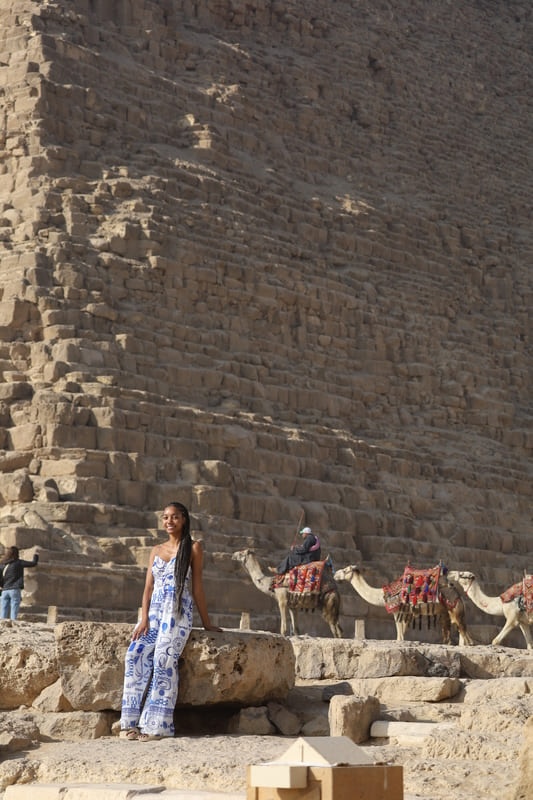
If you’ve already visited the Valley of the Kings in Luxor, going inside the pyramids might feel underwhelming by comparison.
- Cost to enter: ~150–600 EGP (~$5–$20 USD), depending on the pyramid.
- The Great Pyramid of Khufu is the most expensive, while the smaller pyramids cost less.
RELATED ARTICLE: Best Time to Climb Table Mountain
Panoramic View of the Pyramids & Camel Rides
There are nine pyramids in total at the Giza complex, but the best panoramic view is from a scenic spot where you can see six pyramids at once.
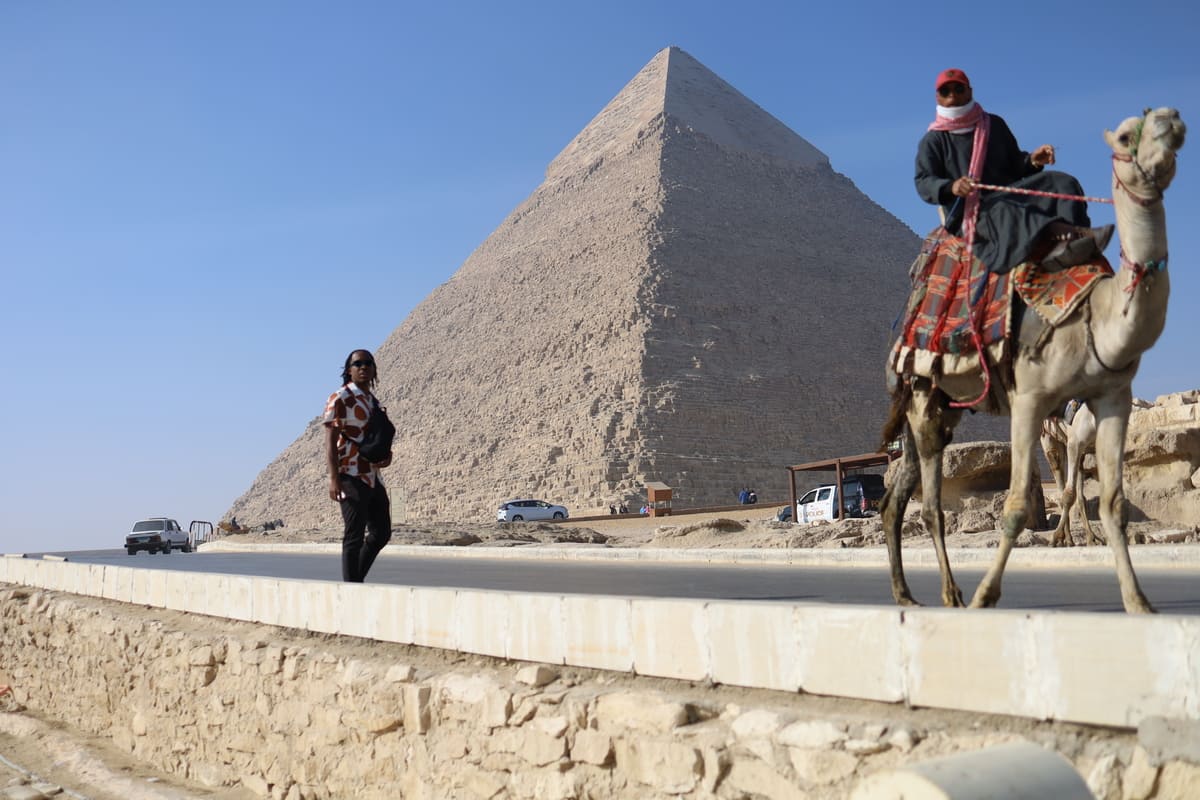
Getting to the viewpoint requires walking about 1.5 hours through the desert sands, but if you’re not up for the trek, you have two classic options:
- Camel ride: Locals offer camel rides to the panoramic point.
- Horse carriage: Another option if you’d prefer not to ride a camel.
We were quoted around 500 EGP (~$10 USD) for two people for either option. The price is negotiable, so feel free to bargain a bit.
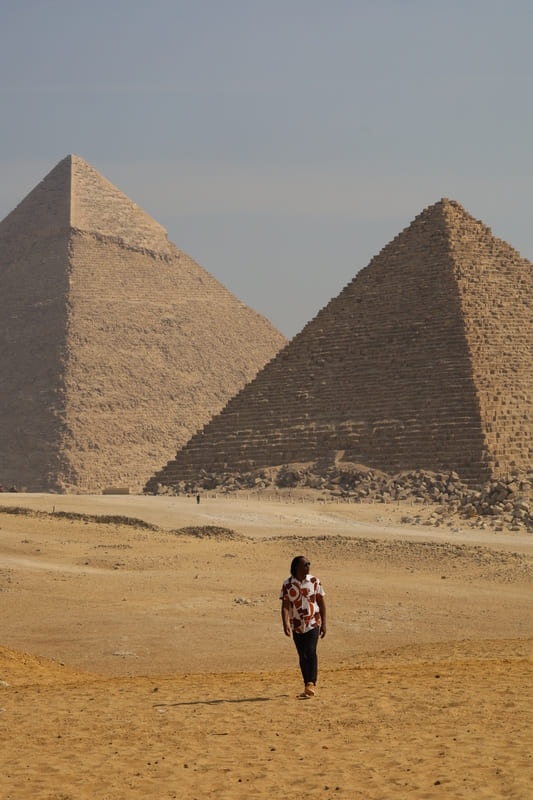
RELATED ARTICLE: Top Things to Do in Cape Town
Great Sphinx of Giza
The Sphinx is located within the same complex as the Pyramids, so you won’t need a separate ticket—it’s included with your general admission.
The Sphinx is an iconic limestone statue with the body of a lion and the head of a pharaoh, believed to represent Pharaoh Khafre.
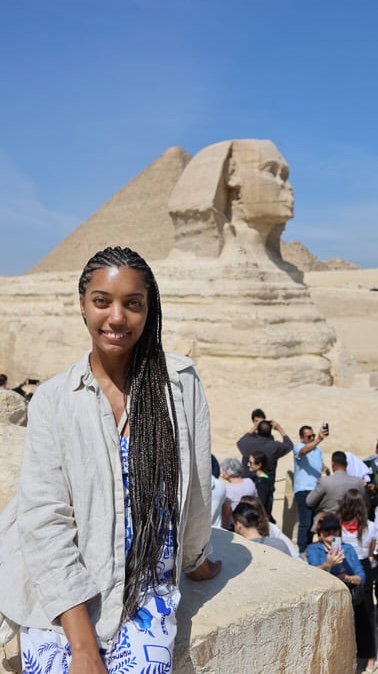
It’s thought to symbolize strength and wisdom, standing as a guardian of the pyramids.
While the Sphinx is impressive to see in person, it’s not as massive as you might expect.
Still, it’s worth stopping by to admire its weathered face, missing nose, and the sheer age of the structure.
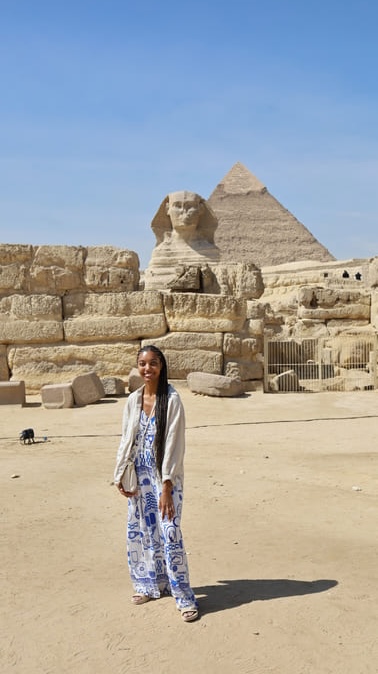
Camera Scams
One thing to be aware of: Cameras are allowed, but you may run into security asking for a bribe.
On our first visit, we passed through with no issues carrying our Canon camera.
The second time, the same security guard suddenly claimed cameras weren’t allowed and held onto it until we handed over some Egyptian pounds.
Chew Tip: To skip the hassle of carrying your camera through security, leave it in your driver’s car when you buy your ticket and grab it after you’ve gone through security. This only works if your driver (or guide) is meeting you on the other side, though. Your driver or guide will need a local entry ticket and a separate ticket for their car to meet you there.
How Much to Budget
- Entry ticket: 700 EGP ($14 USD) per adult.
- Camel or horse carriage ride: 500 EGP ($10 USD) for two people (negotiable).
- Optional pyramid entry: 150–600 EGP ($5–$20 USD) per person per pyramid.
- Total estimate: ~$15–$50 USD per person, depending on extras.
Pyramids 9 Lounge
If you’re looking for a restaurant with prime pyramid views, Pyramids 9 Lounge is the spot. It was our favorite place to eat near the pyramids—both for the view and the laid-back vibe.
The lounge is located inside the pyramids complex, but far enough in that you’ll need a car to get there.
This means your driver needs their own entry ticket along with a car ticket to access the complex.
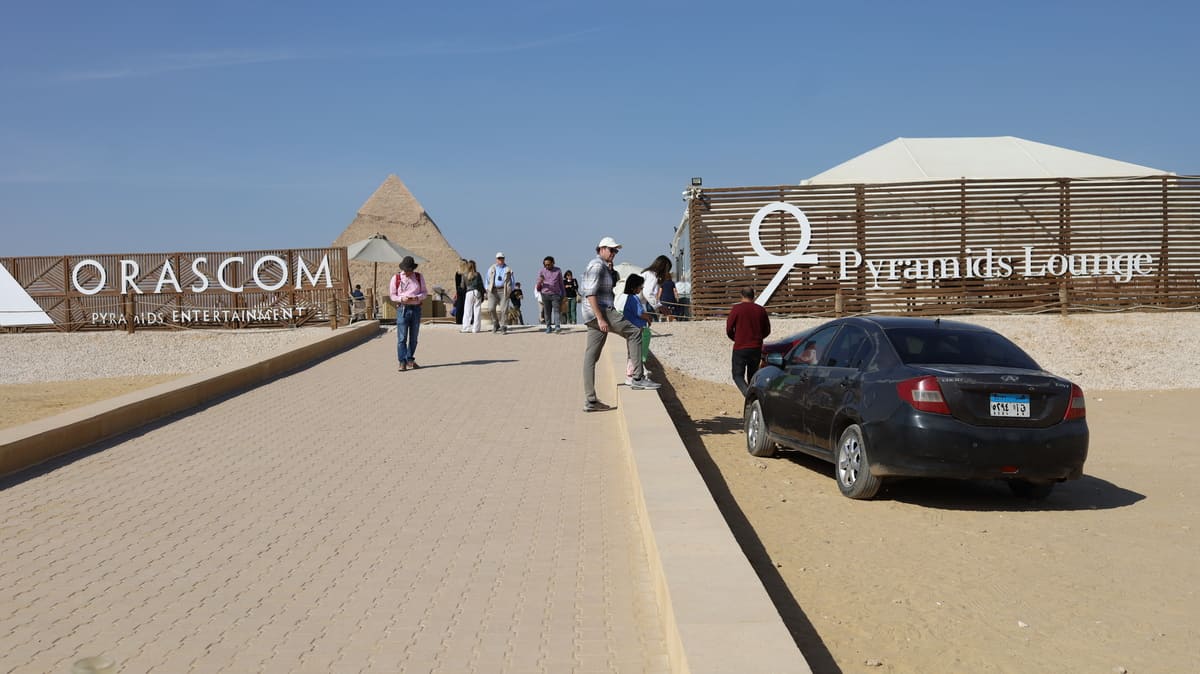
How to Get There
When you arrive at the pyramids entrance, buy three tickets right away:
- Your entry ticket (~700 EGP / ~$14 USD per adult).
- Local entry ticket for your driver (~40 EGP / ~$0.80 USD).
- Car ticket (~40 EGP / ~$0.80 USD).
After you purchase your tickets, give the driver their entry and car tickets before you walk through security.
Your driver will meet you on the other side and take you to the lounge.
Chew Tip: Go to the lounge first before exploring the pyramids. That way, you avoid needing to exit the complex and buy another entry ticket. We made the mistake of exploring the pyramids first, then realizing we needed a driver to get to the lounge. Since all drivers wait outside the complex, we had to exit and were told we couldn’t reuse our original entry tickets. We ended up paying for entry twice—don’t make the same mistake!
The Lounge Experience
The lounge has both indoor and outdoor seating, but the outdoor area is the real draw.
There are plenty of tables, and if you’re lucky, you can have a front-row seat with unobstructed views of the pyramids.
- When we arrived, we were initially seated a few rows back, but once a front-row table opened up, the staff kindly moved us.
- Below the front-row tables, there’s a chill lounge area with floor pillows and low tables, making it a great spot if you want a more relaxed vibe.
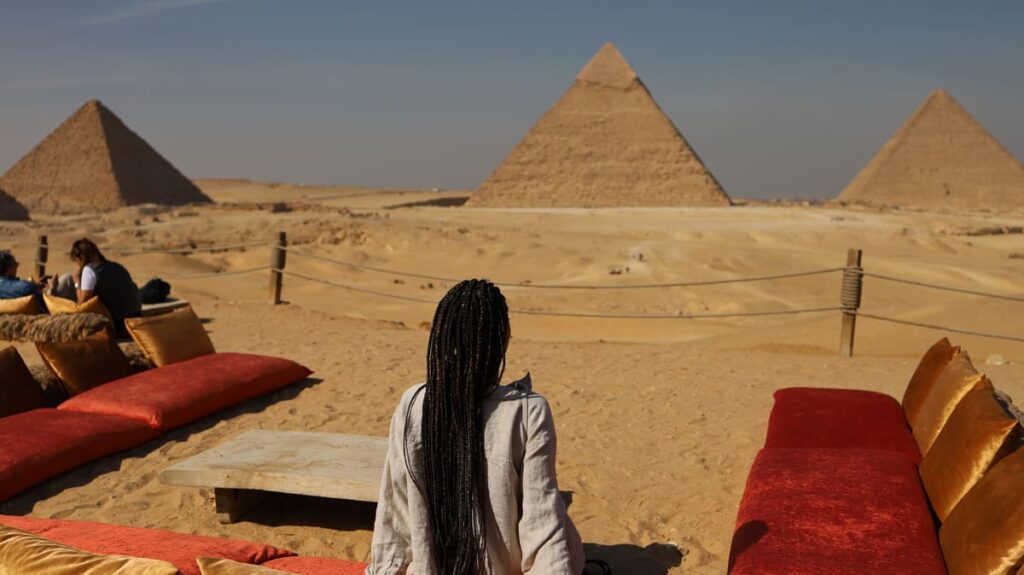
The food was delicious. We got a great taste of traditional Egyptian dishes —hummus, falafel, mixed vegetable tajine, and beef raqqoq.
And of course, you can’t skip the fresh juices and coffees.

How Much to Budget
Here’s what we paid:
- Meal for two: 1400 EGP ($27 USD).
- Pyramids entry ticket: 700 EGP ($14 USD) per adult.
- Driver + car tickets: 80 EGP ($1.60 USD) total.
- Driver waiting fee: 500 EGP ($10 USD) for 2 hours.
- Total estimate: ~$53 USD for two people, including pyramid complex entry, food at the lounge, and driver wait time.
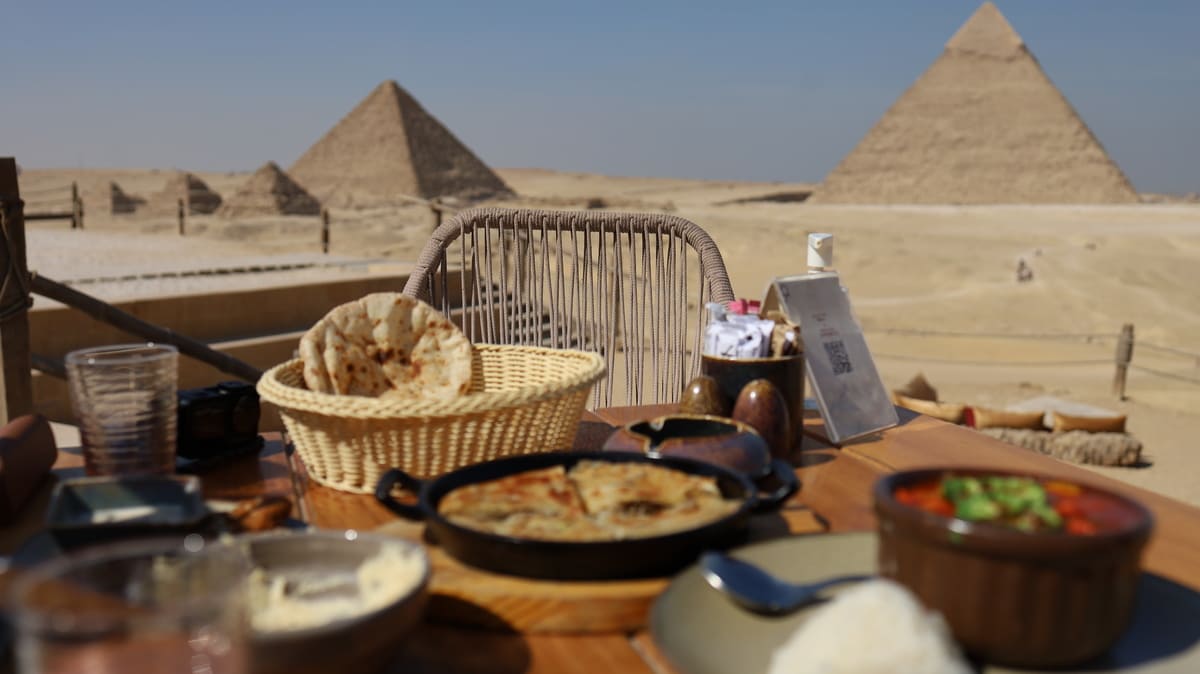
If you’re planning to visit the Pyramids of Giza, Pyramids 9 Lounge is well worth adding to your itinerary—just be sure to go here first to avoid paying for entry twice.
Grand Egyptian Museum (GEM)
The Grand Egyptian Museum (GEM) is brand new and still partially under construction, but it’s already an incredible place to visit.
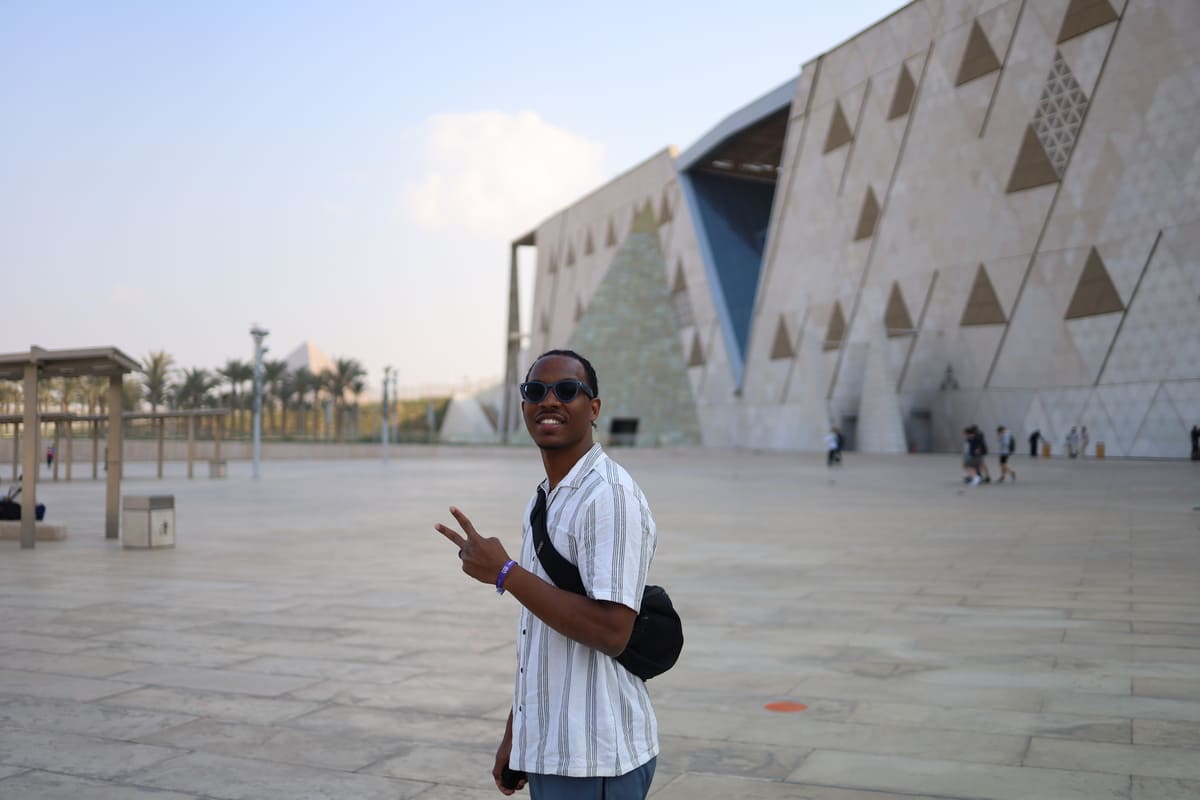
Even though some exhibits weren’t open yet during our visit in March 2025 (like Gallery 3, the King Tut exhibit, and the Children’s Museum), the museum itself is massive and packed with fascinating history.
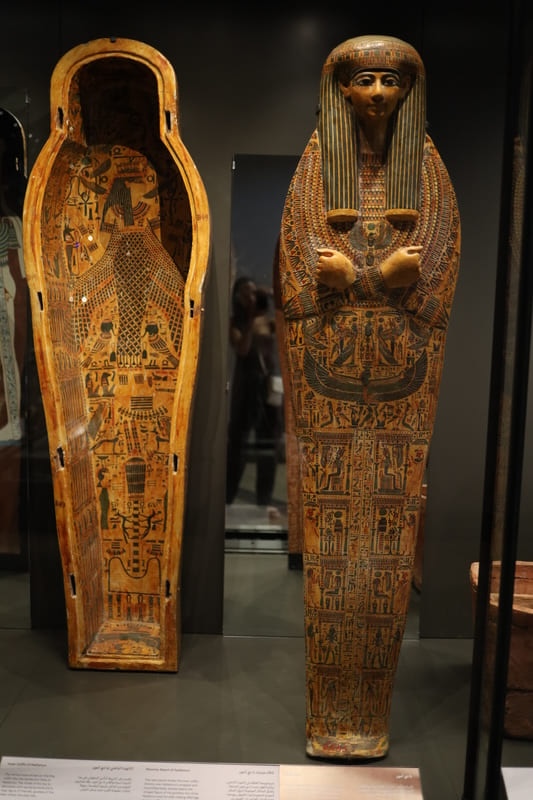
Even if you’re not usually a museum person, this one is worth it. We found it to be engaging and impressive.
It offers detailed insights into ancient Egypt, and you’ll walk away with a much deeper appreciation for the country’s history.
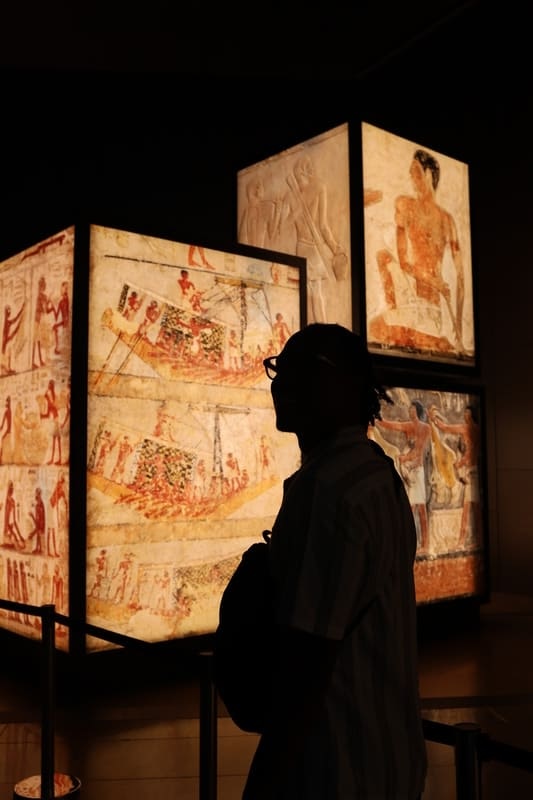
What You’ll See
GEM is the largest museum in the world dedicated to a single civilization, and its size alone is mind-blowing. Highlights include:
- The Hanging Obelisk at the entrance, which is a striking welcome piece.
- The Grand Hall featuring statues of ancient Egyptian pharaohs.
- The Grand Staircase lined with over 80 colossal statues.
- The Main Galleries, showcasing thousands of ancient artifacts, including mummies and relics dating back over 8,000 years.
- A large cafeteria with tons of restaurant options, making it easy to grab a meal or snack during your visit.
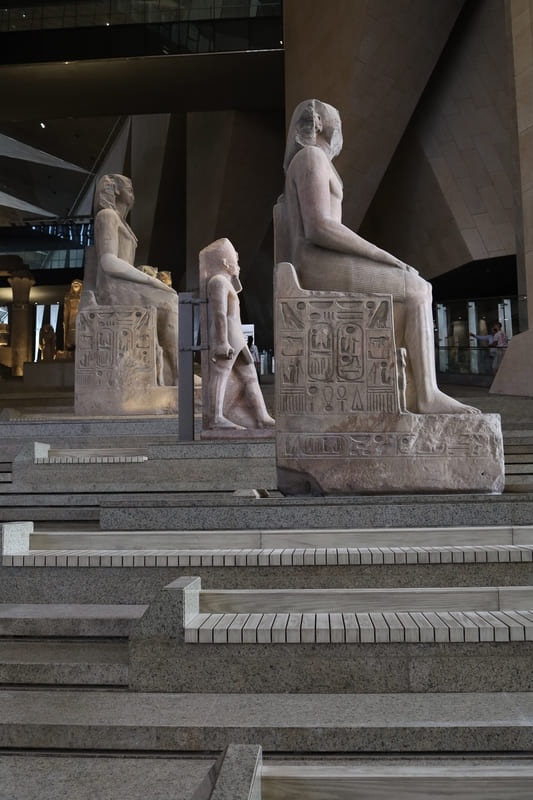
Chew Tip: Since not all exhibits are open yet, it’s worth checking the official website or reviews before you go to see what’s accessible.
How Much to Budget
- Adult ticket: 1270 EGP ($25 USD).
- Children and students with valid ID: 635 EGP ($13 USD).
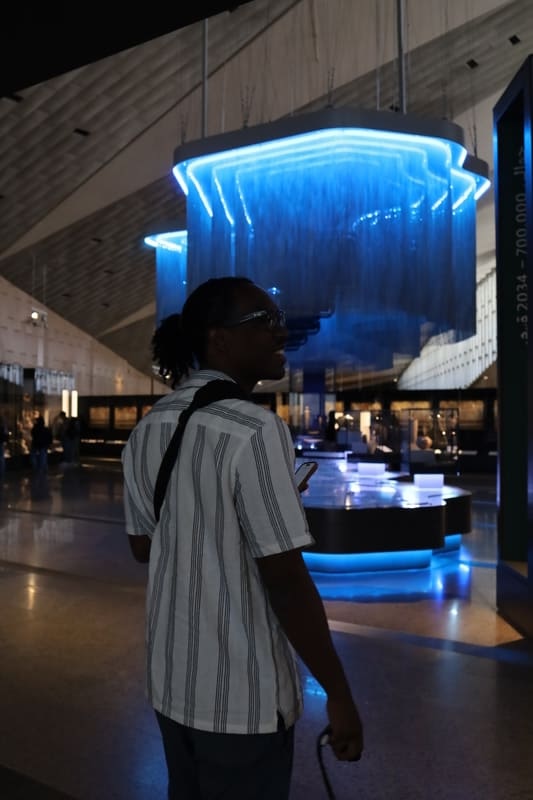
Akemi Egypt Restaurant
After exploring the Grand Egyptian Museum, head across the street to Akemi Egypt Restaurant for a meal with a view.
The rooftop terrace offers stunning views of the museum and the Pyramids of Giza, making it the perfect spot to check out.
The menu has plenty of variety, including vegetarian options. We ordered:
- Lentil soup and penne arrabbiata with a mango beach drink.
- Dynamite shrimp and chicken cream soup for my husband.
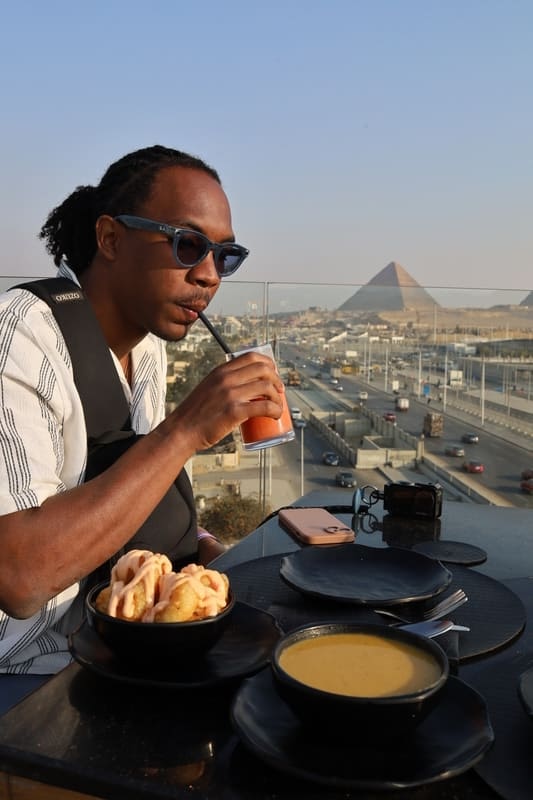
The food was flavorful, and the staff was friendly and welcoming.
While the views are the real highlight, the quality of the meal made it a worthwhile experience.
Chew Tip: If you can, time your visit for sunset. Watching the pyramids and museum light up as the sun goes down makes the meal even more memorable.
How Much to Budget
- Meal for two: ~1400 EGP (~$29 USD).
If you’re visiting the Grand Egyptian Museum, Akemi Egypt Restaurant is the perfect place to grab a bite with epic views.
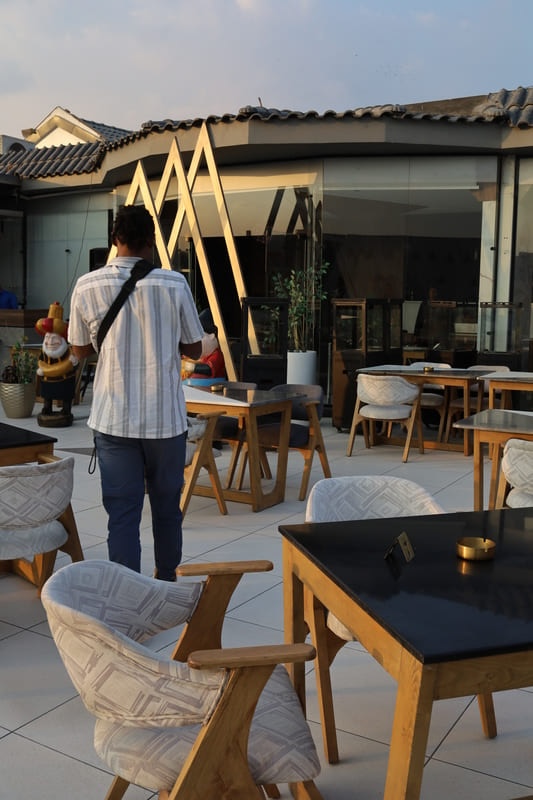
RELATED ARTICLE: Where Do Nubians Live in Egypt?
Khan El Khalili Market
If you’re wondering what to do in Cairo besides the pyramids, here’s one of them.
Let me preface this by saying: Cairo’s markets are on another level when it comes to sales tactics.
Nothing can fully prepare you for how persistent the sellers are.
They will do everything they can to make a sale, whether you’re interested or not.
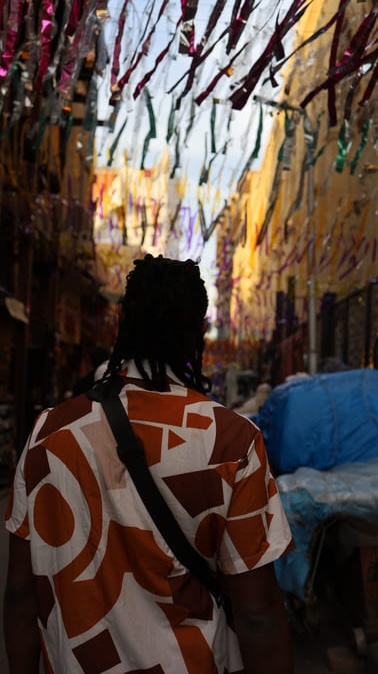
My husband actually admired the hustle, but as someone more introverted, I found it overwhelming at times.
The vendors can be incredibly friendly, but their friendliness is often part of the sales pitch.
A simple “no, thank you” doesn’t always cut it—you’ll need to repeat it firmly and consistently if you’re not interested.
Chew Tip: If you’re struggling to leave a shop, one trick I used was saying, “I have to catch my flight”—it made my exit seem more urgent and believable. It also gave the impression that I’d already spent most of my money, which helped cut down on their persistence.
Shopping at Khan El Khalili
Khan El Khalili is one of the most famous markets in Old Cairo.
You’ll find just about everything here—from traditional clothing and jewelry to carpets, papyrus scrolls, ceramics, perfume oils, and spices.
It’s a one-stop shop for souvenirs, but be ready to haggle—prices are highly negotiable.
We came specifically looking for traditional Egyptian outfits.
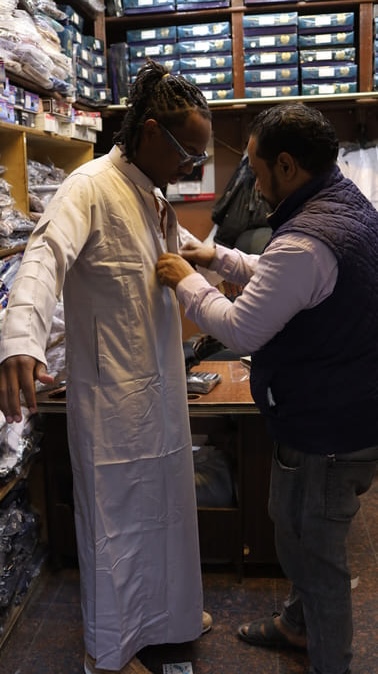
To start, we walked through the market, casually glancing at different outfits without showing too much interest.
The key is to play it cool—the moment you show the slightest interest, the merchant will lock in on you and push for the sale.
After scoping out a few shops, we finally found the perfect outfits at a price point we were comfortable with.
We negotiated and paid ~$23 USD total for two outfits, which felt like a win.
Feeling satisfied, we were ready to move on—but that’s when the real hustle kicked in.
After seeing us make a purchase, another merchant insisted we visit their shop.
Thirty-five minutes and $40 USD later, we walked out with a bottle of oil that we hadn’t planned on buying.
It was a classic tourist trap moment.
In hindsight, we should have been more firm and left when we initially said no.
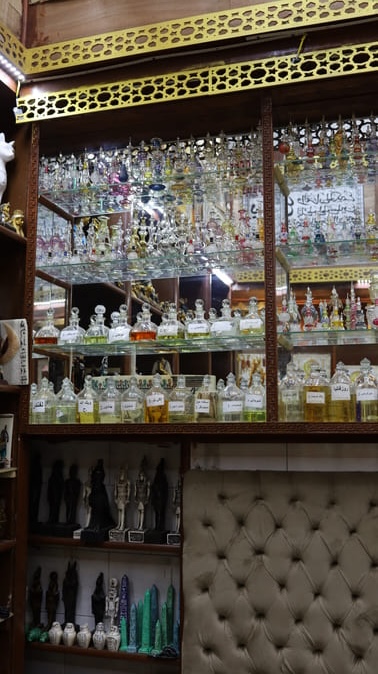
Chew Tip: If you want to avoid falling into this trap, be direct and confident. A firm “no” and walking away quickly is your best defense.
How Much to Budget
There’s no set budget for Khan El Khalili—it entirely depends on how much you’re willing to spend.
The market is one big negotiation game, so you can pay as much or as little as your bargaining skills allow.
RELATED ARTICLE: What are the Scams in Egypt?
Al-Azhar Mosque
Islam is the predominant religion in Egypt, and you’ll find countless beautiful mosques throughout the country.
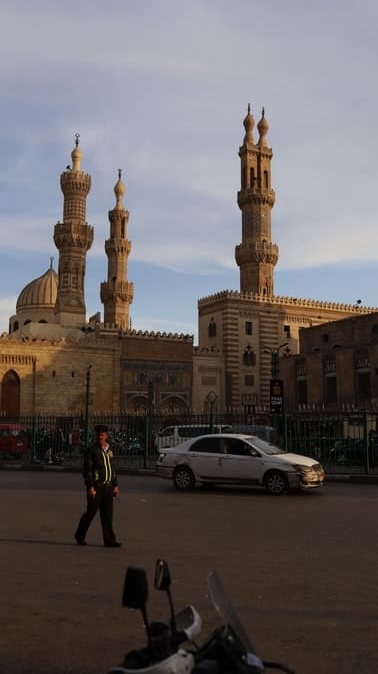
Al-Azhar Mosque is located in Islamic Cairo and dates back to 970 AD.
The mosque is quite peaceful, with its marble courtyard reflecting the sunlight.
Inside, you’ll find a mausoleum and prayer halls, all featuring impressive architecture and detailed carvings.
It’s definitely worth a stop to take in the beauty.
Chew Tip: When visiting, dress modestly out of respect for the religious site. Women should bring a scarf to cover their hair, and both men and women should wear clothing that covers their arms and legs.
How Much to Budget
- Free to enter, though donations are appreciated.
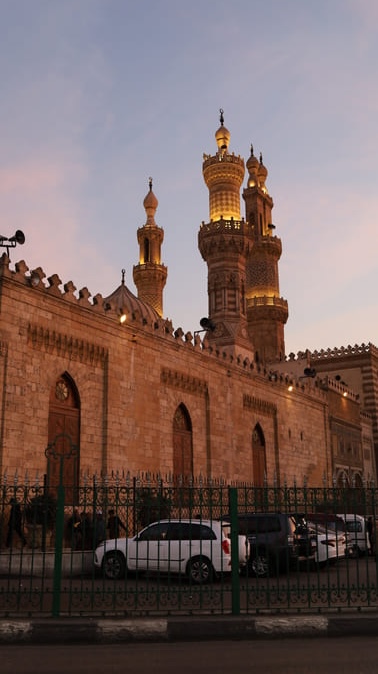
Al-Muizz Street (Al-Muizz li-Din Allah Al-Fatimi Street)
Al-Muizz Street is one of Cairo’s oldest and most famous streets, running through Islamic Cairo.
It’s essentially an open-air museum, lined with stunning medieval architecture, mosques, schools, and historical buildings.
Walking down this street feels like stepping back in time.
How Much to Budget
- Free to walk the street.
- Some buildings charge a small entry fee (typically 100-200 EGP or ~$2-4 USD).
- Budget extra if you plan on shopping or dining along the way.
The Cave Church (Monastery of Saint Simon)
While Islam is the dominant religion in Egypt, Coptic Christianity is the second largest religious group.
The Cave Church, also known as the Monastery of Saint Simon, is a remarkable open-air Coptic Christian church carved into Mokattam Mountain in Cairo.
Located in Garbage City, home to the Zabbaleen community, who are known for their work as waste collectors and recyclers, this church is one of the unique things to do in Cairo.
With its amphitheater-style design, Bible verses etched into the rock, and massive carvings of religious figures, it’s a stand-out place to visit.
Chew Tip: Getting to the Cave Church can be tricky. Some drivers may refuse to take you due to the rough and narrow roads. It’s best to pre-arrange transportation with a trusted guide or driver (who will also either wait or come back for you.)
How Much to Budget
- Free to visit.
Felucca Ride on the Nile
One of the most memorable experiences in Cairo is taking a traditional felucca ride on the Nile River.
These wooden sailboats offer a peaceful way to see the city from the water, with beautiful views of Cairo’s skyline and landmarks.
You can book a felucca ride for a set duration, usually ranging from 30 minutes to a couple of hours.
While you’re on the water, you’ll get a chance to relax and soak it all in. The sunset rides are especially stunning.

How much to budget
A typical felucca ride costs around $10-25 USD for a 30-minute to 2-hour ride.
Prices can vary depending on the length of the ride and whether you book in advance or just show up and negotiate on-site.
You can book your felucca ride ahead of time to secure a fixed price and avoid any haggling.
RELATED ARTICLE: Unique Things to Do in Luxor
Aroka Healing Center
After a bit of exploring, you might be craving a little relaxation and one of those non-touristy things to do in Cairo.
Aroka Healing Center is a wellness spa offering a variety of treatments, including deep tissue massages, aromatherapy, and relaxation massages.
It’s the perfect spot to unwind and recharge after a day of sightseeing.
The atmosphere is calm and soothing, and the staff is friendly and professional.
Whether you’re dealing with sore legs from walking or just need a moment of peace, Aroka is a solid choice.
Chew Tip: There are multiple locations but it’s worth booking in advance since they can get busy.
How Much to Budget
- 60-minute aromatherapy massage: ~$30 USD.
- Prices vary depending on the treatment you choose.
Day Trips from Cairo
While there’s plenty to do in Cairo itself, taking a day trip is a great way to experience more of Egypt’s rich history and landscapes.
Keep reading for a few nearby destinations worth considering.
Alexandria
Located on the Mediterranean coast, Alexandria offers a blend of ancient history and coastal charm.
It’s about a 2.5 to 3-hour drive from Cairo, making it a popular day trip.
Things to see in Alexandria:
- Catacombs of Kom el Shoqafa: An ancient Roman burial site with intricate carvings and tombs.
- Bibliotheca Alexandrina: A modern revival of the ancient Library of Alexandria, with exhibitions and reading rooms.
- Amphitheatre of Alexandria: A Roman-era theatre with marble seating and columns.
- Pompey’s Pillar: A massive Roman column and landmark in Alexandria.
Chew Tip: Alexandria’s coastal atmosphere makes it feel like a refreshing escape from Cairo’s desert heat. 👉🏽 Check tour prices for Alexandria
Al Fayoum Oasis
Just 2 hours southwest of Cairo, Al Fayoum is perfect for nature lovers.
This ancient oasis offers a mix of scenic landscapes, history, and wildlife.
Things to see in Al Fayoum:
- Lake Qarun: A salty, scenic lake with birdwatching opportunities.
- Fayoum Museum: Home to Roman-era mummy portraits and ancient artifacts.
- Wadi El-Rayan: A desert area with small waterfalls, perfect for photos.
- Felucca ride: You can sail on a traditional Egyptian boat and enjoy the peaceful surroundings.
Chew Tip: If you enjoy outdoor adventures, Al Fayoum offers hiking, desert views, and water activities. 👉🏽Check tour prices for Al Fayoum
Saqqara & Dahshur
Just 30-40 minutes from Cairo, Saqqara and Dahshur offer a less crowded but equally fascinating pyramid experience.
Things to see in Saqqara & Dahshur:
- Step Pyramid of Djoser: The oldest pyramid in Egypt, built in the 27th century BC.
- Red Pyramid: Known for its smooth-sided design, it’s one of the first true pyramids.
- Bent Pyramid: Recognizable by its unique slanted shape, making it a rare architectural sight.
- Memphis: The ancient capital of Egypt, which is where you used to find King Ramses II’s massive limestone statue that is now in the entry of the Grand Egyptian Museum.
👉🏽 Check tour prices for Saqqara & Dahshur
How Much to Budget
- Alexandria: Tours typically range from ~$70-150 USD per person, including transport and guide.
- Al Fayoum: Around $90-190 USD per person for a full-day tour.
- Saqqara & Dahshur: Private tours cost around ~$50-80 USD per person, depending on group size.
Chew Tip: While tours are convenient, you may save money by arranging your own transportation. Compare Uber prices to these destinations and decide what fits best with your itinerary and budget.
Cairo FAQs
Is 3 days in Cairo enough?: Yes, 3 days in Cairo is enough to see the main attractions like the Pyramids, Grand Egyptian Museum, and local markets.
What do tourists typically do when visiting Cairo, Egypt?: Tourists typically visit the Pyramids of Giza, explore the Grand Egyptian Museum, wander through markets like Khan El Khalili, and tour historic mosques such as Al-Azhar Mosque.
Is Cairo safe for tourists?: Cairo is generally safe for tourists, and we felt safe our entire trip, but it’s important to stay alert, especially in crowded areas like markets or public transport.
Is there Uber in Cairo?: Yes, Uber is available in Cairo, but many drivers prefer cash payment instead of the in-app card payment. Be prepared to confirm payment methods with your driver before starting your trip.
Is Cairo cheap to visit?: Cairo can be affordable, with budget-friendly accommodation and food options. However, attractions and guided tours can add up, so plan your budget accordingly.
What are the do’s and don’ts in Cairo?: Do dress modestly, use Uber or Careem for safe transport, carry small cash for tips, and bargain at markets. Don’t drink tap water, take unofficial taxis, engage with aggressive vendors, or photograph military buildings.
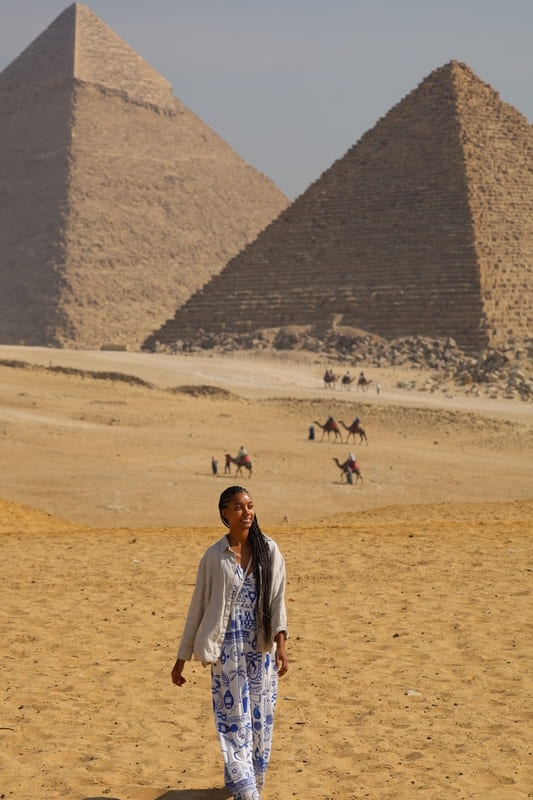
Conclusion: Is Cairo Worth Visiting?
Cairo is worth visiting—whether you’re fascinated by ancient wonders, want to immerse yourself in local culture, or simply enjoy experiencing busy cities.
Whether you’re exploring the pyramids or wandering through markets, the city has plenty to keep you engaged.
If you have time, day trips to places like Alexandria or Saqqara are worth considering.
And whether you’re visiting Egypt for a few days or an extended stay, Cairo is a city that leaves a lasting impression.
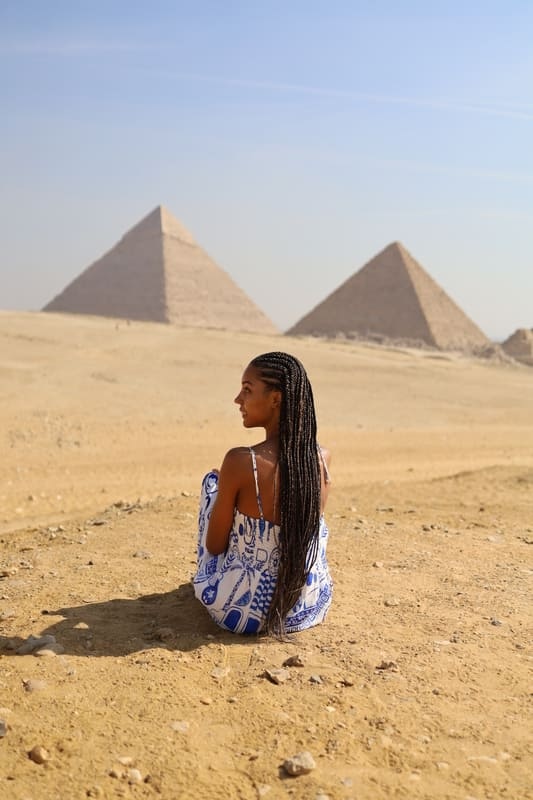
Related Egypt articles to read next:
Found this article helpful? Share it!


